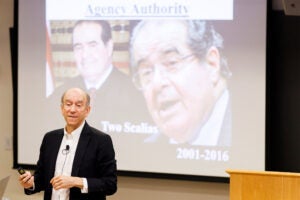Education’s future, globally
Conference tackles problems facing students in many nations
Future generations of leaders in international education gathered at the Harvard Graduate School of Education (HGSE) last week to explore solutions to some of the world’s most pressing challenges in the field.
The conference, “Defining the Future of Global Education,” featured the presentations of final projects by close to 50 master’s students in the HGSE course “Education Policy Analysis and Research in Comparative Perspective,” taught by Fernando Reimers, Ford Foundation Professor of International Education.
“The themes discussed during the conference and the commitment of presenters, discussants, and attendees gives me great hope,” said Reimers, “that during the next 10 and 20 years we are going to see even more progress in expanding the dream of providing quality and relevant education to all around the world.”
Topics ranged from reforming civic education in Saudi Arabia to increasing educational opportunities for female students in rural Lao PDR to teacher absenteeism in India to China’s college entrance examination to English language literacy in American Samoa.
Student Mark Huelsman cited persistent college attainment gaps between low- and high-income students during a talk on increasing access to higher education for low-income students in the United States.
To reverse the troubling trend, he suggested a number of policy reforms, including simplifying financial aid applications and delivering financial aid to students well before they reach high school. He also called for the reform of higher education tax credits. Such credits should be refundable, Huelsman said, and students should have the option of receiving them before they are in debt to higher-education institutions.
“I think these two policies could actually have the effect of engaging students early and promoting college-going behaviors.”
With her paper, Maria Vanya Anaya Antelo explored how to change negative attitudes toward immigrants in France through the use of culturally sensitive teaching practices and multicultural education strategies. Needed are components of culturally relevant teaching that include the development of active listening techniques, the presentation of multiple perspectives during class discussions, and the creation of an atmosphere of inclusion in the classroom, said Antelo.
“Every student in the classroom should feel that they can contribute to the learning community, [and] feel comfortable expressing their beliefs in a safe space.”
Audience members and moderators for the various sessions included education leaders from around the world, including Reyes Tamez Guerra, the former secretary of education of Mexico, Susan Durston, the director of education for the United Nations Children’s Fund, and Khattab Al-Hinai, a member of the Oman state council and the chair of its committee on education.
The oldest independent state in the Arab world, Oman is in the process of assessing and evaluating the country’s educational system, said Al-Hinai, who attended the Harvard conference to listen and learn.
“I need to learn everything, the financing of education, the quality of education … everything. We need to get it right.”
Also in the crowd was Manuel Gonzalez, a volunteer parent in the California school district that his five children attended, including his oldest son, now a Harvard sophomore.
“It’s not foolish to think of high aspirations, of educational reforms that are on the face feasible, like convincing our society of the value that undocumented students can represent if you open the gates of academic training,” said Gonzalez, referencing a morning session by HGSE students MaryAnn Celis and Megha Tanwar.
The pair, who discussed the use of programs to help improve college access for undocumented youths in the United States, said that each year 65,000 undocumented students put their college dreams on hold. Financial constraints are part of the problem, they said. Because of their undocumented status, illegal immigrants have to pay higher out-of-state tuition prices and are ineligible for work-study aid programs.
The research showed that when such students can pay in-state tuition, as is the case with 13 states, their enrollment rates increase and dropout rates decrease.
“Addressing the financial barrier would be to grant in-state tuition,” said Celis.




